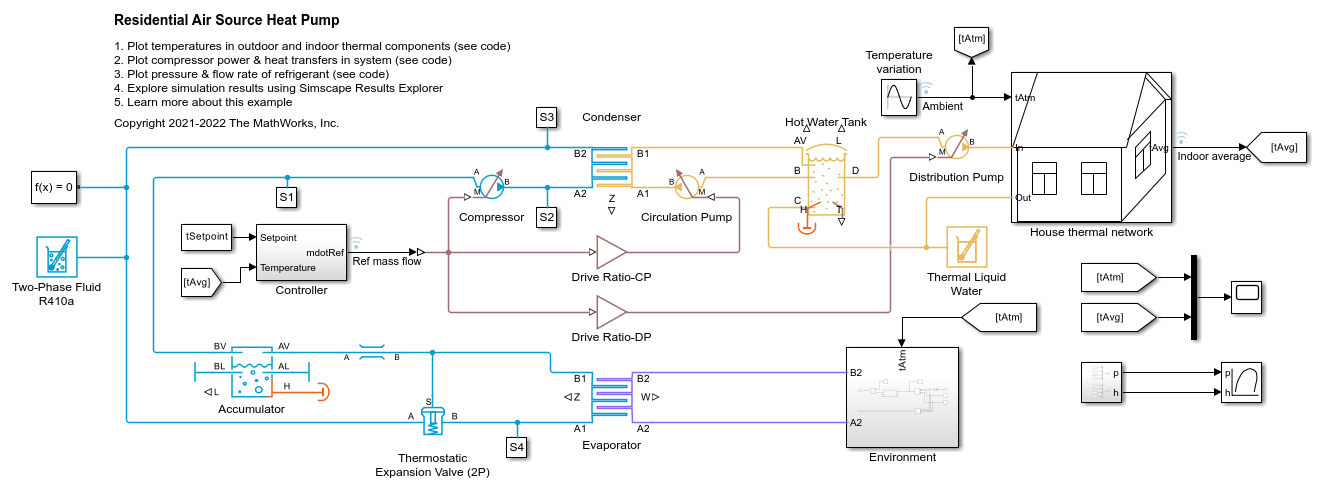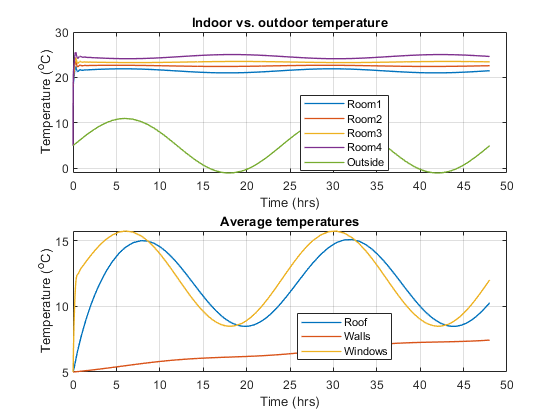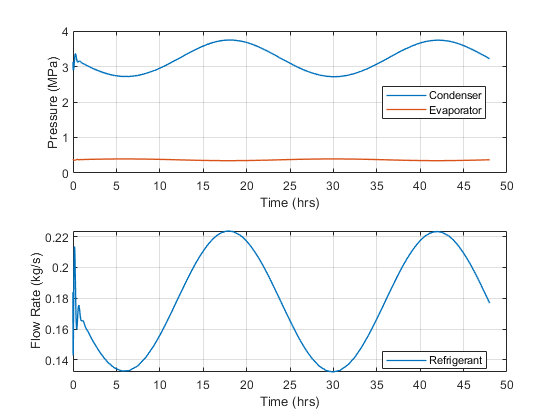Residential Air Source Heat Pump
This example models an air source heat pump system that is used to heat a residential building having hot-water radiators for heat distribution. The two-phase fluid refrigerant takes up heat from the environment moist air mixture and transfers heat to water. The compressor drives the R410a refrigerant through a condenser, a thermostatic expansion valve, and an evaporator. An accumulator ensures that only vapor returns to the compressor.
A fan drives moist air flow over the evaporator. A circulation pump drives water flow through the condenser and hot water exiting condenser is stored in a hot water storage tank. A distribution pump drives hot water flow from the tank to the radiators. A PI controller modulates the refrigerant mass flow rate to keep the average air temperature of the building at around the setpoint temperature of 23 degC, as the ambient temperature varies between -1 degC to 11 degC.
The residential building has four radiators and four rooms. Each room exchanges heat with the environment through its exterior walls, roof, and windows. Each path is simulated as a combination of a thermal convection, thermal conduction, and the thermal mass. It is assumed that heat is not transferred internally between rooms. The initial indoor temperature of the rooms is equal to the ambient temperature of 5 degC, and the heat pump quickly increases the average indoor temperature to the setpoint temperature of 23 degC.
Model

House Thermal Network Subsystem

Radiator Subsystem

Room Subsystem

Controller Subsystem

Temperature Controller Subsystem

Environment Subsystem

Simulation Results from Scopes

Simulation Results from Simscape Logging
This top subplot shows the temperature variation of each room compared to the outside temperature fluctuations. This bottom subplot shows the average overall temperatures of roof, walls, and windows. The initial indoor temperature of the rooms is equal to the ambient temperature of 5 degC, and the heat pump quickly increases the average indoor temperature to the setpoint temperature of 23 degC.

This top subplot shows the power consumed by the compressor, the heating load of the heat pump system, which is the rate of heat transfer in the condenser, and the rate of heat transfer in the evaporator. This bottom subplot shows coefficient of performance which is the ratio of the heating load and the power consumed. These plots show that more energy is being consumed when heat load is higher, i.e when ambient temperature is lower, and less energy is being consumed when heat load is lower, i.e when ambient temperature is higher, while the coefficient of performance stays nearly constant for the entire duration.

This top subplot shows refrigerant pressure and this bottom subplot shows refrigerant mass flow rate. The high pressure line oscillates between 2.6 MPa to 3.7 MPa and the lower pressure line oscillates between 0.34 MPa to 0.4 MPa. The refrigerant flow rate oscillates between 0.13 kg/s to 0.23 kg/s. The higher pressures and flow rates correspond to lower ambient temperatures, when the heat pump needs to transfer more heat, while the lower pressure and flow rates correspond to higher ambient temperatures, when the heat pump needs to transfer less heat.

